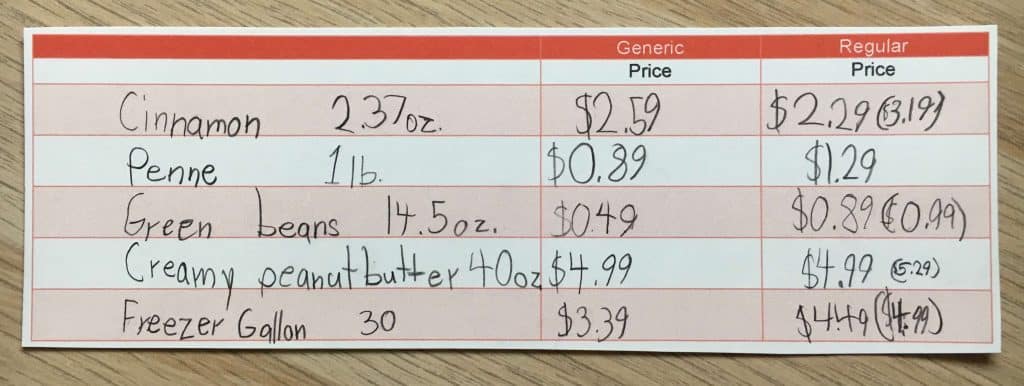The wheels have been turning since I wrote my last post, If I Could Teach My Child Just One Financial Lesson, It Wouldn’t Be To Save (spoiler: it would be to spend wisely). And I really enjoyed doing a five part series on saving, so I thought, why not do another series on spending?
J and I have been going to various stores and doing some comparison shopping, so the first three posts will be the results of our research, including practical advice and lessons about spending. Specific topics will include buying generic vs. name-brand products, looking at price differences between stores and buying in bulk.
Post four will include other ideas for teaching your kids about spending, and the last post will be more philosophical in nature — do I really need to buy this?
Generic vs. Regular
When I first thought of this idea, I mentioned it to J and he said, “What does generic mean?”
Wait, what?
It hit me — a lot of things we know and take for granted as adults, kids don’t always understand yet.
I had to explain that a name-brand product is one you know — it’s advertised on TV, the Internet and anywhere else products are advertised nowadays.
A generic product, on the other hand, isn’t advertised. It’s a similar product — in taste and packaging, but it’s often a bit cheaper. (I found a few old posts like this one from History’s Dumpster and this one from Gone But Not Forgotten Groceries that talk about true generic products from the 80s — the white boxes with black text. Those don’t really exist in the same form today, so I’ll use the term generic to mean store-brand products.)
The Plan
We went to Target, and we walked around the store looking for five products to compare. His picks were cinnamon, penne, green beans, creamy peanut butter and gallon freezer bags. You know, all the typical stuff.
He wrote the item and size, the price for the generic product and the price for the name-brand product. In some cases, the name-brand product was on sale, so he wrote the sale price and then the regular price.

While we walked and wrote, we talked about comparing like products (making sure the size and type were the same) and how to read the price tags on the shelves carefully. I allowed enough time for the activity so that we weren’t rushed and only chose five products so that it wasn’t a chore to do. I think J enjoyed the trip and conversations (when he normally doesn’t like going to the store).
The Conversations
In mostly all cases, the generic product won out on price. In one case, the regular product won because it was on sale (cinnamon) and in another case, there was a tie (peanut butter) — again, because it was on sale.
The big conversation here was to check sale prices vs. generic prices. (There are other ways to get items cheaper, including using coupons, store apps like Cartwheel and store cards like the Target card, all of which I cover in part 4.)
Lesson: Don’t just assume the generic brand is cheaper. Always check the prices!
Then we discussed preferences. One of the items we compared was peanut butter. I don’t know about you, but I have preferences on peanut butter (Jif for life!). So it doesn’t matter to me how much cheaper the Target-brand peanut butter is, I won’t buy it because it doesn’t taste as good. (Here’s a great article from CBS Money Watch that basically says the same thing about Heinz ketchup. I totally agree.)
However, we compared penne as well. To me, there’s no noticeable difference between Target brand penne and Barilla, so I’m fine buying the generic version.
Lesson: Don’t buy something you don’t like just because it’s cheaper. It’s not actually cheaper if you don’t use it.
Lastly, we discussed quality. None of the items we looked at had quality issues, however think about products like toilet paper, paper towels and tissues. I know I’ve bought generic versions of these before and have been dissatisfied with the quality.
Lesson: If you don’t like the quality of a generic product, spring for the brand name. Again, it’s not actually cheaper if you never use it and it’s not worth hating something you buy just to save a little bit of money.
Spending and You
How does it go in your house? What do your kids see you doing? Do you buy generic? Why or why not?
Want to try this activity for yourself? Download the free template.
And don’t forget to join us next time when we talk about comparing prices between stores!

